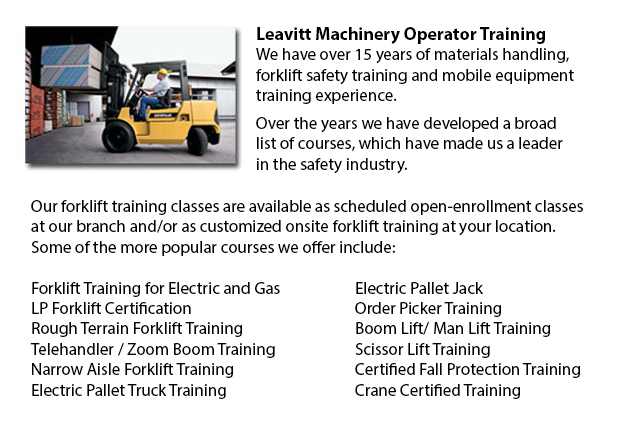
Forklift Training Schools Vaughan - Have A Safe And Efficient Work Place With Our Forklift Training Schools
Are you looking for a job as a driver of a forklift? Our regulatory-compliant mobile equipment operator training provides instruction in types of forklifts, pre-shift inspection, fuel types and handling of fuels, and safe operation of a forklift. Practical, hands-on training helps individuals participating in acquiring basic operational skills. Course content consists of existing rules governing the operation of forklifts. Our proven forklift courses are designed to provide training on these types of trucks: powered pallet truck, narrow isle forklift and counterbalanced forklift.
Do not raise or lower the fork when the lift truck is traveling. A load must not extend above the backrest because of the risk of the load sliding back in the direction of the operator. Inspect for overhead obstructions and make sure there is sufficient clearance prior to lifting a load. Stay away from overhead power lines. Once the load is raised straight up, tilt it slightly back.
While the load is raised the forklift would be less stable. Make certain that no pedestrians cross underneath the elevated fork. The operator should not leave the forklift while the load is raised.
While handling pallets, forks should be high and level enough to go into the pallet and extend all the way underneath the load. The width of the forks should provide equal weight distribution.
Chock the wheels and set the brakes prior to unloading and loading the truck. The floors should be strong enough to support the combined weight of the load and the forklift. Fixed jacks could be installed in order to support a semi-trailer that is not attached to a tractor. The height of the entrance door should clear the height of the forklift by at least 5 cm. Edges of docks, rail cars and ramps should be marked and avoid them.
-
Forklift License Vaughan
Forklift License Vaughan - Getting a forklift certification or forklift license in North America would require the trainee to do hands-on training in addition to classroom instruction. The provincial, federal and state regulatory bodies are responsib... More -
Forklift Ticket Vaughan
Forklift Ticket Vaughan - Forklifts and the pallet jack is meant for just about the same reason. They work to raise and move supplies and goods from one place to another. This however is where the comparison stops though. With the pallet jack, the be... More -
Aerial Lift Certification Vaughan
Aerial Lift Certification Vaughan - Aerial Lift Certification is for individuals who need an in-depth understanding of aerial lift safety. Operators and inspectors, supervisors, maintenance workers and construction craftsmen should perform a certific... More -
Manlift Certification Vaughan
Manlift Certification Vaughan - The Manlifts and Elevated Platforms course provides training on the rules, regulations and proper application of safe operating measures and work practices included in everyday activities for those who work making use... More -
Heavy Equipment Training Vaughan
Heavy Equipment Training Vaughan - The two most common kinds of heavy equipment training are categorized into the categories of machines; equipment that is fashioned with rubber tires or those with tracks. The tracked vehicle are heavy duty machines... More -
Boom Lift Ticket Vaughan
Boom Lift Ticket Vaughan - Boom lifts are equipment that has a platform that may be lowered or raised to different heights, thus making this piece of equipment an important necessity in a wide variety of professions. Offered in many different particu... More -
Telehandler License Vaughan
Telehandler License Vaughan - The telescopic handler or telehandler is a frequently used equipment in industrial and agricultural applications. This particular machine is the same in appearance to a forklift and also functions in a similar way, altho... More -
Scissor Lift Training Vaughan
Scissor Lift Training Vaughan - Scissor lifts have to be operated competently to be able to protect the safety of the machinery and the safety of others within the workplace. Operators who are skilled are trained to drive the particular kind of sciss... More

Forklift Training Vaughan
TOLL FREE: 1-888-254-6157
Vaughan, Ontario
forklifttrainingvaughan.com
Email Us
About Us


